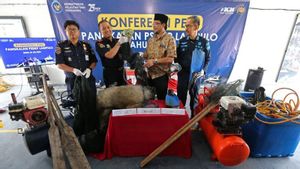JAKARTA - Various artifacts full of historical value were exhibited at the Central Institute for Restoration office, which is located in a former female prison in central Rome, Italy on Tuesday morning.
Various objects ranging from bronze statues of human size to small Roman coins, oil painting to mosaic floors, these objects date back to the 9th century BC to the 2nd century AD and are works of art stolen and traded for one year which were confiscated by a team of Manhattan prosecutors, Colonel Matthew Bogdanos and returned to Italy.
The traded works, looted from Italy in Lazio, Campania, Puglia, Calabria and Sicily, were confiscated in New York and New Jersey, United States last year.
The works returned, along with 60 items returned last year, were worth more than US$80 million (Rp1,300,408,000,000), but only water in the ocean when compared to artwork still hidden in private warehouses and displayed at museums in the United States, Bogdanos told CNN on the sidelines of a presentation to the media on Tuesday, as quoted on May 29.
Bogdanos mengatakan, item senilai 80 juta dolar AS itu tidak termasuk 100 item lainnya yang baru saja disita timnya di AS.
Meanwhile, Carabinieri Commander for Cultural Heritage Protection General D. Francesco Gargadro said it was very difficult to confiscate and return the stolen artifacts, as authorities often did not know what they were looking for.
"When artifacts were taken from a secret grave, the artifact was never cataloged," he said.
That means, apart from the items themselves, the historical context was also stolen, so archaeologists lost valuable information. (On the other hand, investigators are working backwards, assessing the documents and claims of the origin of the artifacts given by the owner, as well as conducting technical tests to ascertain the true origin of an object.)
Most of the items recently returned to Italy were excavated from secret excavations or stolen from churches, museums and individuals, Gargaro said.
Among the items exhibited on Tuesday were an iron chest protector and two bronze heads from the 4th to 3rd centuries BC that were confiscated from a gallery owner in New York.
There is also a bronze statue of Umbria depicting a soldier who was stolen from an Italian museum in 1962 found in a well-known American museum.
There is also a mosaic floor depicting the myth of Orpheus enchanting wild animals with a voice from the middle of the 3rd to the middle of the 4th century AD was rediscovered after being stolen from a secret excavation in Sicily in the early 1990s. The object was confiscated from the private collection of a well-known collector in New York.
Italy's Carabinieri Cultural Heritage Protection Unit uses artificial intelligence to search for stolen cultural assets under a new program called the "Curian Art Work Detection System" (SWOADS), which searches for stolen items by scanning the web and social media to find images.
SEE ALSO:
"Returning cultural assets that is very important to Italy, both because of its numerical consistency and historical and artistic values, is another significant achievement," said Italian Deputy Culture Deputy Minister Gianmarco Maazzi.
"In addition to being very valuable works of art, these works represent high expressions of our national history, culture and identity," he explained.
In 2023, 105,474 works of art worth more than 264 million euros were discovered and confiscated worldwide thanks to artificial intelligence projects, according to Gargaro.
The English, Chinese, Japanese, Arabic, and French versions are automatically generated by the AI. So there may still be inaccuracies in translating, please always see Indonesian as our main language. (system supported by DigitalSiber.id)


















